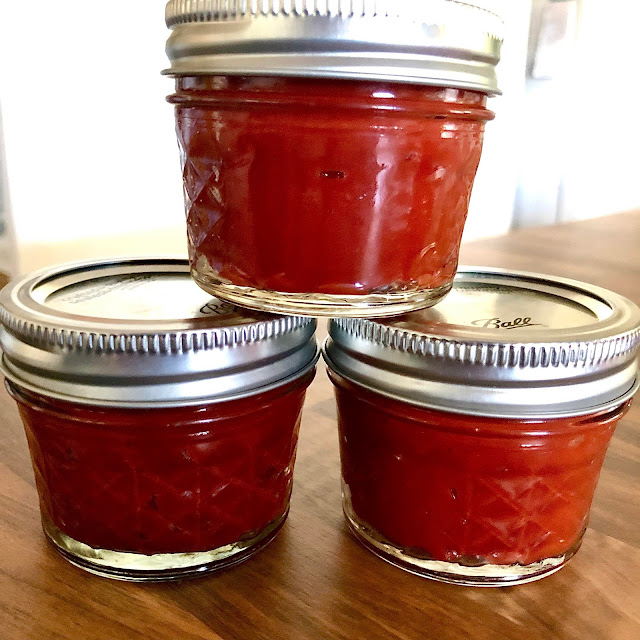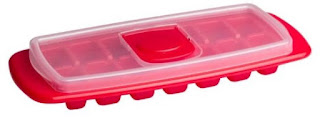When tomato puree is cooked for several hours until thick, the richly
flavoured tomato concentrate can be bottled to use all year long. Have excess homegrown
(or locally grown) tomatoes? Make a batch of your own tomato paste!
|
Ingredients
for TOMATO PASTE
|
|
|
|
Yield: 8-9 cups
|
|
Tomatoes, Roma*
|
6.3kg (14 pounds)
|
|
Citric Acid
|
1 teaspoon
|
|
Salt, Finely Ground
|
1 teaspoon (optional)
|
|
*Fresh or thawed tomatoes can be used. Other “paste/plum” tomato varieties
can be used - they are dense with less seeds and are long or pear shaped.
Some examples include Amish paste, black
prince, Italian gold, opalka, Polish linguisa, principe borghese, san marzano, saucy and sausage.
|
|
METHOD:
NOTE: Only
half-pint jars (1 cup/250ml or smaller in volume) are suitable for this recipe.
2. Wash tomatoes. Discard spoiled tomatoes (damaged tomatoes will affect
the flavour, reduce storage period and increase risk of spoilage). Remove
tomato cores.
3. Spread tomatoes on an oven tray in a single
layer. Do not add any oil. Roast on low
heat until skins split.
4. Remove trays from the oven and cool tomatoes
to touch.
5. Discard tomato skins (skins can be set aside
to dehydrate into tomato powder) and run roasted tomatoes through a passata
machine, food mill or sieve to discard seeds.
6. Place tomato puree into a large pan. Add
citric acid and stir well. Simmer tomato puree gently until it is as thick as
possible – this can be done in a slow cooker on low, or in a low-temperature oven
(using an oven-proof dish) or on the stove top (on low simmer, in a wide based
pan if possible).
NOTE: This
reduction is “low and slow” – on low heat to prevent scorching and slowly to
remove the water content – until the mixture is very thick (i.e. halved in
volume). This may take hours, depending on the method used to reduce the tomato
puree.
7. When the tomato paste is ready: place the lids
into a heatproof bowl and cover the lids with boiling water. Remove the lids
from the water when you are ready to place them onto the jars to
seal.
8. Place jars onto a heatproof surface i.e. wood
board (or tea towel).
9. Fill jars with hot tomato paste, filling to 1.25cm
(1/2 inch) from the rim of each jar.
TIP: use a
jar funnel to fill jars.
10.
Using a non-metal utensil (i.e. chopstick), remove any bubbles and add more hot
tomato paste if required to correct the headspace if it dropped below 1.25cm
(1/2 inch) from the jar rim.
11. Wipe jar rims with a damp paper towel to
remove any food residue.
12. Remove lids from hot water and seal jars i.e. twist to secure
“fingertip tight”.
13. Place
jars of tomato paste into the pot of boiling water and boil for the processing
time stated below. Start the timer once the water comes back to a full boil.
14. Turn off the heat source once the time is up. Remove jars from hot
water after 5 more minutes. Cool jars overnight on a heatproof surface i.e.
wooden board or towel. Do not adjust lids during this time.
15.
After 12-24 hours: check jars have sealed before labelling and dating clearly.
16. Store jars of tomato paste in a cool, dark and dry place (i.e.
pantry) for up to 12 months.
Jar lids should remain tightly sealed during storage, and not flex up or
down when pressed (which indicates jar seal failure, do not consume).
17. Refrigerate jars upon opening and consume contents within 5 days.
TIP: Freeze
leftover tomato paste from opened jars in freezer safe containers (we recommend
storing in the freezer in an ice cube tray that has an airtight lid, example
pictured).
|
Processing Time for TOMATO
PASTE in a Boiling Water Canner
|
|||||
|
Altitude Processing Times
|
|||||
|
Packing
Style
|
Jar Size
|
0-1000 ft
|
1001-3000 ft
|
3001-6000 ft
|
6000+ ft
|
|
Hot Pack
|
Half-Pint (250ml/1
cup)
or smaller
|
45 minutes
|
50 minutes
|
55 minutes
|
60 minutes
|
Author:
Megan Radaich
Image Credit: Megan Radaich



